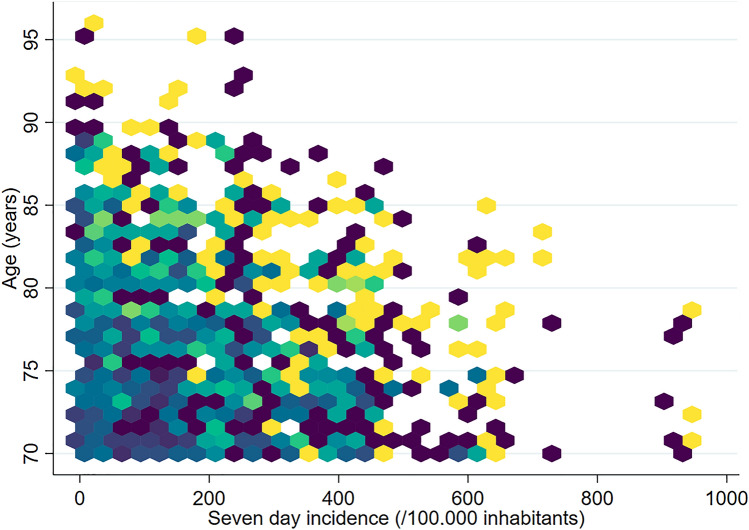Dear Editor,
The pandemic caused by SARS-CoV-2 coronavirus disease 2019 (COVID-19) disproportionally affected the elderly population especially in the initial phase. During the different surges of the pandemic, some intensive care units (ICUs) were overwhelmed by a huge influx of patients. Criteria were discussed for patient admission as well as for possible limitation of care. This had to be done despite an increase in bed capacity to avoid exhaustion of resources. Evidence-based thresholds for ICU patient-to-caregiver ratios [1], above which patient safety may be endangered, were not realistic to provide during the COVID-19 pandemic in many countries.
Criteria about resource allocation should ensure fairness, enhance consistency, and decrease moral distress in providers [2]. It has been heavily debated whether chronological age or age cut-offs can serve as criterion to guide therapy decisions. For example, Dutch ethicists even developed triage guidelines for when patients cannot be discerned based on medical differences. Whom should then be admitted to the last ICU bed? Younger generation could be prioritized over older generation in that horrible scenario. This could be considered to be discriminatory and the question whether age in itself should be considered acceptable as a selection criterion remains unsolved. What is considered ethically acceptable or not differs between societies as is illustrated by the huge differences in, for example, end-of-life care or withholding of treatments while being admitted to the ICU [3]. Our analysis sought to investigate the relationship between the decision to limit therapy and the 7-day incidence of COVID-19 patients as a surrogate of ICU pressure in elderly patients.
The Corona Virus disease in Very Elderly Intensive care Patients (COVIP study) was a multinational, prospective, observational study in elderly ICU patients. This analysis included 2984 patients from 35 countries. The 7-day incidence was retrieved from the World Health Organization (WHO) database [4] and matched with the individual patients’ date of symptom onset in the respective country. Further characteristics recorded and the definition of treatment limitation such as withholding or withdrawal were described previously [5]. Data were analyzed using the hexagon heat map illustration tool and logistic regression analysis in STATA (IC 16.1, TX, USA).
Figure 1 shows the relationship between limitation of care, the 7-day incidence, and age. A shift in the frequency of treatment limitations can be found toward also younger ages with increasing incidences. In multivariable logistic regression, the odds for treatment limitation were independently associated with age [adjusted odds ratio (aOR): 1.07 per year (confidence interval 1.06–1.09, p < 0.001] and 7-day incidence (aOR 1.12 per 100/100.000 (confidence interval 1.06–1.18, p < 0.001) adjusting for sex, frailty, and disease severity (Sequential Organ Failure Assessment Score).
Fig. 1.
A 20-step color gradient illustrates the density of the occurrence of the event (withholding or withdrawal of treatment) in relation to age and 7-day incidence. Yellow codes the highest event density; dark blue the lowest
One limitation of our analysis is that we do not have a specific measure of ICU burden, which ideally should take into account staffing, other patients, and emotional burden, among other factors.
In summary, 7-day incidence is likely to play a role in critical-care decision-making in older patients, especially when the health system is under pressure from many admissions.
Funding
Open Access funding enabled and organized by Projekt DEAL.
Declarations
Conflicts of interest
The authors declare that they have no competing interests.
Footnotes
Publisher's Note
Springer Nature remains neutral with regard to jurisdictional claims in published maps and institutional affiliations.
References
- 1.Neuraz A, Guerin C, Payet C, Polazzi S, Aubrun F, Dailler F, Lehot JJ, Piriou V, Neidecker J, Rimmele T, Schott AM, Duclos A. Patient mortality is associated with staff resources and workload in the ICU: a multicenter observational study. Crit Care Med. 2015;43:1587–1594. doi: 10.1097/CCM.0000000000001015. [DOI] [PubMed] [Google Scholar]
- 2.Sprung CL, Joynt GM, Christian MD, Truog RD, Rello J, Nates JL. Adult ICU triage during the coronavirus disease 2019 pandemic: who will live and who will die? Recommendations to improve survival. Crit Care Med. 2020;48:1196–1202. doi: 10.1097/CCM.0000000000004410. [DOI] [PMC free article] [PubMed] [Google Scholar]
- 3.Avidan A, Sprung CL, Schefold JC, Ricou B, Hartog CS, Nates JL, Jaschinski U, Lobo SM, Joynt GM, Lesieur O, Weiss M, Antonelli M, Bulow HH, Bocci MG, Robertsen A, Anstey MH, Estebanez-Montiel B, Lautrette A, Gruber A, Estella A, Mullick S, Sreedharan R, Michalsen A, Feldman C, Tisljar K, Posch M, Ovu S, Tamowicz B, Demoule A, DeKeyser GF, Pargger H, Noto A, Metnitz P, Zubek L, de la Guardia V, Danbury CM, Szucs O, Protti A, Filipe M, Simpson SQ, Green C, Giannini AM, Soliman IW, Piras C, Caser EB, Hache-Marliere M, Mentzelopoulos SD, Group E-S Variations in end-of-life practices in intensive care units worldwide (Ethicus-2): a prospective observational study. Lancet Respir Med. 2021;9:1101–1110. doi: 10.1016/S2213-2600(21)00261-7. [DOI] [PubMed] [Google Scholar]
- 4.https://covid19.who.int/. Last accessed 07 Sep 2021
- 5.Jung C, Flaatten H, Fjolner J, Bruno RR, Wernly B, Artigas A, Bollen Pinto B, Schefold JC, Wolff G, Kelm M, Beil M, Sviri S, van Heerden PV, Szczeklik W, Czuczwar M, Elhadi M, Joannidis M, Oeyen S, Zafeiridis T, Marsh B, Andersen FH, Moreno R, Cecconi M, Leaver S, Boumendil A, De Lange DW, Guidet B, Group CS The impact of frailty on survival in elderly intensive care patients with COVID-19: the COVIP study. Crit Care. 2021;25:149. doi: 10.1186/s13054-021-03551-3. [DOI] [PMC free article] [PubMed] [Google Scholar]



